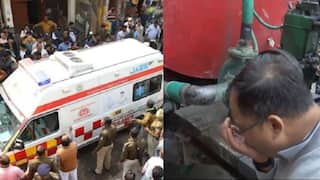National Technology Day 2022: PM Modi Salutes 'Brilliant Scientists' And Vajpayee For Pokhran Nuclear Tests
The Pokhran-II tests, which were a series of five nuclear bomb test explosions, were conducted at the Indian Army's Pokhran Test Range in the Rajasthan Desert in 1998, on May 11 and 13.

New Delhi: On the occasion of National Technology Day, the Prime Minister of India, Narendra Modi, took to Twitter to express gratitude to the nation's "brilliant scientists" and their efforts which led to the successful Pokhran tests in 1998.
The Prime Minister wrote: "Today, on National Technology Day, we express gratitude to our brilliant scientists and their efforts that led to the successful Pokhran tests in 1998. We remember with pride the exemplary leadership of Atal Ji who showed outstanding political courage and statesmanship."
Today, on National Technology Day, we express gratitude to our brilliant scientists and their efforts that led to the successful Pokhran tests in 1998. We remember with pride the exemplary leadership of Atal Ji who showed outstanding political courage and statesmanship. pic.twitter.com/QZXcNvm6Pe
— Narendra Modi (@narendramodi) May 11, 2022
National Technology Day is observed every year on May 11 in India to celebrate the country's technological achievements. On May 11, 1998, India conducted three successful nuclear tests of advanced weapon designs at the Indian Army's Pokhran Test Range under Operation Shakti. In 1999, Vajpayee declared May 11 as National Technology Day.
All About The Pokhran Nuclear Tests
The Pokhran nuclear tests of 1998 are known as the Pokhran-II tests. India's first successful nuclear bomb was conducted on May 18, 1974, as part of Pokhran-I or Operation Smiling Buddha.
The Pokhran-II tests, which were a series of five nuclear bomb test explosions, were conducted at the Indian Army's Pokhran Test Range in the Rajasthan Desert in 1998, on May 11 and 13, and marked the second instance of nuclear testing conducted by India.
The first three detonations took place simultaneously at 3:45 pm IST on May 11, according to a statement issued by the Department of Atomic Energy, Government of India, in 2009. The nuclear devices detonated included a 45 kiloton thermonuclear device, a 15 kiloton fission device, and a 0.2 kiloton device, which is a sub-kiloton device. The two nuclear devices detonated simultaneously on May 13 were also in the sub-kiloton range — 0.5 kiloton and 0.3 kiloton.
The tests, led by former President APJ Abdul Kalam, made India an official member of the elite club of nuclear power nations. For his work on the development of ballistic missile and launch vehicle technology, Kalam came to be known as the Missile Man of India.
Vajpayee had said in the Parliament that India will not take the first step in the use of nuclear weapons. He had said that atomic weapons can be used for defence purposes.
The Atomic Energy Commission said in a statement that the yield of the thermonuclear tests were further confirmed through comparison of ground motion and displacement simulation with actual observations on the field.
The Pokhran-II tests were fully successful in achieving their scientific objectives and the capability to build fission and thermonuclear weapons with yields up to 200 kilotons. Since May 1998, a great deal of further scientific and technical development work has taken place.
Related Video
Vande Bharat: India’s First Vande Bharat Sleeper Train to Run Between Guwahati and Kolkata





































